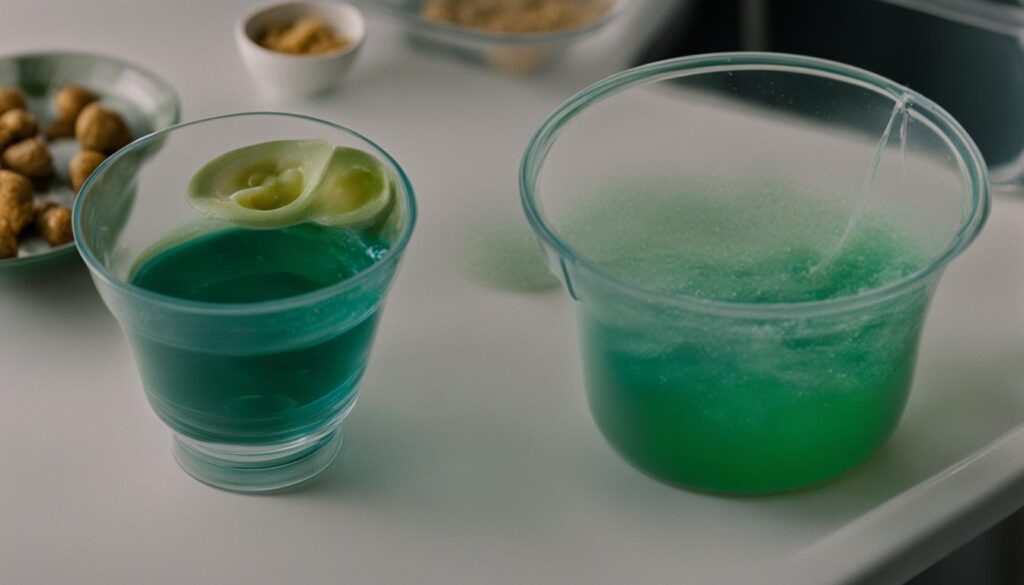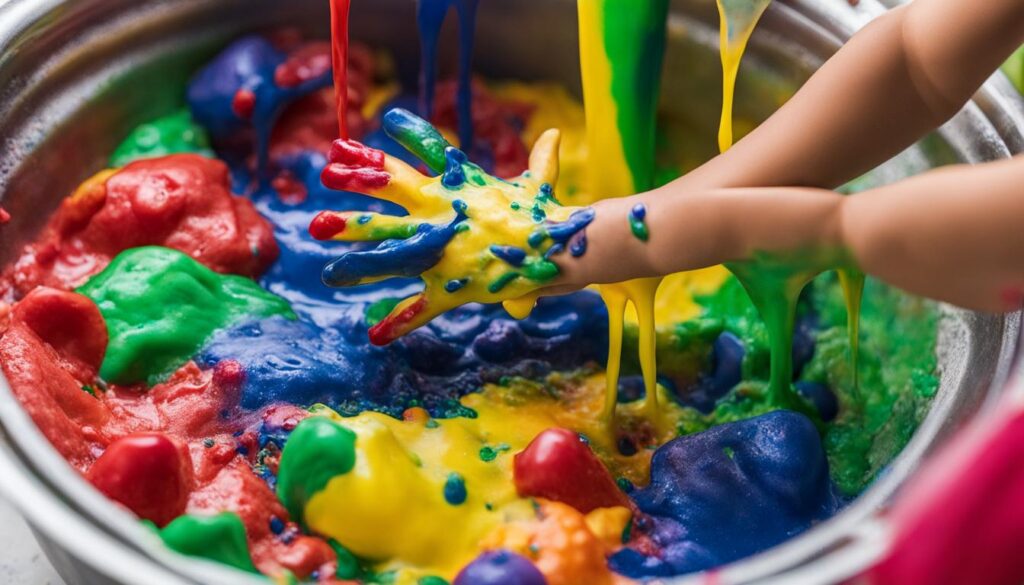Are you looking for a fun and educational activity for your kids? Look no further than oobleck! Oobleck is a fascinating non-Newtonian fluid that behaves like both a solid and a liquid. It’s easy to make at home with just a few simple ingredients.
To make oobleck, all you need is cornstarch and water. Simply mix 1 1/2 cups of cornstarch with 1 cup of water. Adjust the consistency as needed by adding more cornstarch or water. You can even add some tempera paint for a pop of color.
Oobleck is a great sensory play activity for kids. They can squeeze it, shape it, and watch it flow. It engages their senses and promotes fine motor skills development. Plus, it’s a fantastic way to introduce them to the fascinating properties of non-Newtonian fluids.
So gather your little ones and get ready for hours of fun with this easy oobleck recipe!
Key Takeaways:
- Oobleck is a non-Newtonian fluid that can behave as both a solid and a liquid.
- The main ingredients for an easy oobleck recipe are cornstarch and water.
- Adjust the consistency of the oobleck by adding more cornstarch or water.
- Oobleck is a great sensory play activity that promotes fine motor skills development.
- Playing with oobleck is a fun and educational way to explore the properties of non-Newtonian fluids.
What Is Oobleck and Its Origins?
Oobleck is a fascinating substance made of a simple mixture of cornstarch and water. It exhibits unique properties, behaving as both a solid and a liquid depending on the amount of pressure applied. This peculiar characteristic makes oobleck a perfect subject for science experiments and educational activities.
The name “oobleck” comes from the book “Bartholomew and the Oobleck” written by the renowned author Dr. Seuss. In the story, oobleck is a green goo-like substance that falls from the sky and creates chaos in the kingdom of Didd. Although the oobleck in the book is not made of cornstarch and water, its influence has led to the widespread use of the term “oobleck” to describe this unique non-Newtonian fluid.
Oobleck is a fantastic way to introduce children to the world of science and teach them about the states of matter and non-Newtonian fluids. Through hands-on experimentation with oobleck, children can experience firsthand how a substance can transition between being solid and liquid, depending on external forces.

The Benefits of Playing with Oobleck
Playing with oobleck provides numerous benefits for kids. It engages their senses and promotes sensory exploration. Oobleck’s unique texture offers tactile stimulation and encourages fine motor skills development.
- Tactile Stimulation: The gooey and squishy consistency of oobleck provides a sensory experience that engages a child’s sense of touch. Squeezing, stretching, and molding the oobleck helps children develop their tactile sensitivity.
- Fine Motor Skills Development: Manipulating oobleck by pinching, scooping, and pouring helps strengthen the muscles in a child’s fingers and hands, promoting fine motor skills development.
- Creative Exploration: Playing with oobleck encourages children to explore and experiment with its properties. They can observe how it flows, drips, and changes shape, stimulating their creativity and curiosity.
- Scientific Thinking: Oobleck’s unique behavior as a non-Newtonian fluid can spark scientific thinking in children. They can observe how it behaves differently when pressure is applied or released, prompting them to investigate and make hypotheses about its properties.
- Calming and Stress-Relieving: The sensory experience of playing with oobleck can have a soothing effect on children. The soft and malleable texture can help alleviate stress and promote emotional well-being.
Engaging in sensory play with oobleck can provide a fun and educational experience for kids, fostering their cognitive, physical, and emotional development.

“Playing with oobleck engages children’s senses, promotes fine motor skills, and sparks scientific thinking.”
How to Make Oobleck with Common Household Items
Making oobleck is a simple and enjoyable activity that requires just a few common household items. With a little creativity and experimentation, you can have homemade oobleck ready for hours of sensory play.
The main ingredients for oobleck are cornstarch and water. These pantry staples can be easily found in most households, making it a cost-effective DIY project. To begin, gather the following items:
- 1 1/2 cups of cornstarch
- 1 cup of water
Start by combining the cornstarch and water in a large mixing bowl. Stir the mixture thoroughly until it becomes a thick and gooey substance. Adjust the consistency as needed by adding more cornstarch or water. The goal is to achieve a honey-like or molasses-like texture that can be molded and shaped.
If desired, you can add a splash of tempera paint to your oobleck mixture to give it vibrant colors. This step is optional but adds an extra touch of visual appeal to the sensory experience.
Check the consistency of your oobleck by slowly pressing your fingers into it. It should feel solid if you apply quick force but liquify and flow when you release pressure.
Remember, making oobleck is a hands-on process, so don’t be afraid to get messy and experiment with different amounts of cornstarch and water until you find the perfect consistency.
Benefits of Making Homemade Oobleck
Creating homemade oobleck not only provides a fun and engaging activity for kids but also encourages sensory exploration and scientific inquiry. By using common household items, you can enjoy the following benefits:
- Promote creativity and imagination through hands-on play
- Develop fine motor skills by molding and shaping oobleck
- Encourage scientific thinking and observation of non-Newtonian fluids
- Provide a calming and stress-relieving sensory experience
Now that you know how to make oobleck with common household items, it’s time to gather your ingredients and let the fun begin!
Tips for Playing with Homemade Oobleck
Playing with oobleck can be a messy yet exciting adventure. Here are a few tips to enhance your oobleck experience:
- Start with a designated play area: Oobleck can get messy, so create a designated play zone by covering the work area with an inexpensive plastic tablecloth or newspaper.
- Explore different textures: Encourage kids to squeeze, pour, and shape the oobleck to explore its unique properties.
- Add tools and containers: Provide various tools such as spatulas, cups, and plastic molds to enhance sensory play options.
- Promote scientific inquiry: Ask open-ended questions and encourage children to make predictions about how the oobleck will behave in different situations.
Remember to supervise young children during play to ensure their safety, and enjoy the exciting world of homemade oobleck!
| Ingredient | Amount |
|---|---|
| Cornstarch | 1 1/2 cups |
| Water | 1 cup |
The Science Behind Oobleck’s Unique Properties
Oobleck is a fascinating non-Newtonian fluid that defies the laws of viscosity. Unlike Newtonian fluids like water or oil, Oobleck behaves in a truly unique and captivating manner. Its extraordinary properties can be attributed to the suspension of cornstarch particles in water, creating a substance that can transition between behaving like a solid and a liquid depending on the applied pressure.
When pressure is applied to Oobleck, such as squeezing it in the palm of your hand, the cornstarch particles align and interlock, forming a solid-like structure. This alignment allows Oobleck to resist deformation and maintain its shape. It’s as if the fluid suddenly becomes a moldable solid, enabling you to form it into balls or shapes.
However, when the pressure is released, the cornstarch particles flow past each other, creating a liquid-like behavior. The substance becomes flowable, allowing it to pour and drip through your fingers. It’s an amazing transformation to observe and experience firsthand.
To further understand this unique behavior, imagine squeezing Oobleck into a ball. The applied pressure causes the cornstarch particles to pack tightly, creating a solid-like state. But once you release the pressure, the particles relax and flow past each other, reverting back to a liquid-like state.
Oobleck’s Dual Nature: Solid or Liquid?
This dual nature of Oobleck is a remarkable example of how matter can exhibit properties that defy our everyday expectations. It challenges the traditional definition of a solid or a liquid, existing in a realm between the two. Its behavior showcases the complex interplay between the microscopic arrangement of particles and our macroscopic perception of matter.
“Oobleck’s ability to transition between solid and liquid states is a testament to the mysterious and fascinating nature of non-Newtonian fluids.” – Dr. Samantha Johnson, Materials Scientist
By exploring Oobleck, we gain insight into the intricacies of non-Newtonian fluids and the scientific principles that govern their behavior. This sensory experience offers a playful and hands-on approach to learning about the properties of matter and the fascinating world of science.
Comparison of Oobleck’s Properties with Newtonian Fluids
| Property | Oobleck (Non-Newtonian Fluid) | Water (Newtonian Fluid) |
|---|---|---|
| Viscosity | Variable viscosity depending on applied force. | Constant viscosity regardless of force. |
| Response to Pressure | Becomes stiff and solid-like under pressure, flows like a liquid when pressure is released. | Maintains its liquid state under pressure, flows freely. |
| Shape Retention | Holds its shape when molded or formed. | Conforms to the shape of its container. |
The table above highlights some key differences between Oobleck and Newtonian fluids like water. While water maintains a constant viscosity and flows freely regardless of applied force, Oobleck’s viscosity varies depending on the pressure exerted. This ability to alternate between solid and liquid states makes it an ideal substance for exploring the principles of non-Newtonian fluids and their intriguing behaviors.
Tips for Playing with Oobleck
Playing with oobleck can be a messy, but incredibly fun and educational experience for kids. Here are some tips to make the most out of your oobleck playtime:
- Prepare the play area: Before diving into the oobleck adventure, cover your work surface with an inexpensive plastic tablecloth or newspaper to make cleanup easier.
- Explore its properties: Encourage kids to really get their hands into the oobleck and explore its unique properties. Squeeze it tightly to form a solid ball, then let it flow through their fingers as a liquid. Discuss and observe how it behaves differently under varying pressure.
- Shape it and form patterns: Experiment with forming shapes and patterns with the oobleck. Kids can try making oobleck sculptures, footprints, or even create oobleck art using tools like cookie cutters or utensils.
- Provide tools and containers: Enhance the sensory play experience by offering various tools and containers for kids to interact with the oobleck. A variety of scoops, spoons, and cups can be used to measure, pour, and transfer the oobleck. This enhances their fine motor skills and creativity.
- Promote scientific inquiry: Use oobleck playtime as an opportunity to stimulate scientific thinking. Ask open-ended questions about the oobleck’s behavior and encourage children to make predictions. Discuss with them why oobleck acts the way it does and explore different experiments they can try with it.
Remember, oobleck is all about sensory play and hands-on learning, so embrace the mess and let the kids explore and discover on their own. It’s a great way to spark curiosity and engage their senses!
Our Favorite Oobleck Tool Recommendations
| Tool | Description |
|---|---|
| Scoops and Spoons | These tools are perfect for measuring and pouring oobleck. They come in various sizes and designs, adding an element of fun and exploration to the play. |
| Utensils | Offering utensils such as forks, knives, and spatulas can provide different ways for kids to interact with the oobleck. They can create patterns, mix colors, or even cut through the oobleck to see how it flows and reacts. |
| Cookie Cutters | Cookie cutters come in various shapes and sizes, allowing kids to create oobleck shapes and designs. They can experiment with pressing the cutters into the oobleck or using them to mold and shape the oobleck into different forms. |
| Containers | Provide a variety of containers such as bowls, cups, and jars to give kids options for containing and manipulating the oobleck. Show them how the oobleck pours differently depending on the container’s shape and size. |
Safety Precautions and Cleanup Tips
When it comes to playing with homemade oobleck, safety is always a top priority. While oobleck is generally safe to play with, it’s important to take a few precautions to ensure a fun and worry-free experience.
Supervision is Key
When playing with oobleck, it’s crucial to supervise young children to prevent ingestion. Although oobleck is non-toxic, it should not be consumed, as it can cause stomach discomfort if large amounts are ingested. So, let’s keep a close eye on our little ones during oobleck playtime!
Tackling Oobleck Stains
Accidents happen, and if any oobleck finds its way onto clothing, don’t worry. Simply scrape off any excess oobleck from the fabric using a spoon or a dull knife. Then, rinse the stained area with cold water. For stubborn stains, pre-treating the fabric with a stain remover before washing can help. Once the clothing is cleaned, it should be as good as new!
Cleanup Made Easy
After an exciting oobleck session, cleaning up doesn’t have to be a hassle. Start by scraping off any excess oobleck from the play surface, disposing of it in the trash. To remove the residue, rinse the area with warm water. And voila, your space is ready for the next round of oobleck fun!
Create a Play Area
To contain the mess and make cleanup even easier, consider designating a specific play area for oobleck. Cover the area with an inexpensive plastic tablecloth or use a designated sensory play tray. This way, you can focus on the play and have peace of mind knowing that the mess is contained in one spot.
Playing with homemade oobleck is an incredibly enjoyable and educational experience. By following these safety precautions and cleanup tips, you can create a safe and clean environment for endless hours of oobleck excitement!
Conclusion
Making oobleck is a simple and enjoyable activity that can provide hours of fun and learning for kids of all ages. With just a few basic ingredients, you can create your very own oobleck at home. The easy oobleck recipe calls for cornstarch and water, and you can add some tempera paint if you want to experiment with colors.
Playing with oobleck offers numerous benefits. It engages children’s senses, allowing them to explore different textures and sensory experiences. As they squeeze and shape the oobleck, they also develop their fine motor skills. Additionally, playing with oobleck introduces children to the fascinating world of non-Newtonian fluids and the unique properties they exhibit.
So, gather your ingredients and get ready for some messy, hands-on fun with oobleck! Follow the simple steps of the easy oobleck recipe to create your own batch. Set up a designated play area, cover it with a plastic tablecloth or newspaper, and let the sensory exploration begin. Whether you’re squeezing it, shaping it, or watching it flow, oobleck is sure to provide endless entertainment and educational value.
FAQ
What is oobleck?
Oobleck is a non-Newtonian fluid made of cornstarch and water. It behaves as both a solid and a liquid, depending on the amount of pressure applied.
How do I make oobleck?
To make oobleck, mix 1 1/2 cups of cornstarch with 1 cup of water. Adjust the consistency by adding more cornstarch or water until it feels like honey or molasses.
What can I add to oobleck for color?
Optional ingredients for color include tempera paint. Add a few drops and mix well to achieve the desired color.
Is oobleck safe for kids?
Oobleck is generally safe to play with, but it should not be consumed. It’s important to supervise young children during play to prevent ingestion.
How do I clean up oobleck?
If any oobleck gets on clothing, it can be easily washed out. Cleanup after play can be done by scraping off excess oobleck and disposing of it in the trash. The remaining residue can be rinsed off with warm water.
- Master Crochet Stitches for Cozy Creations - January 23, 2024
- Half Double Crochet Guide for Cozy Creations - January 23, 2024
- Elevate Your Space with Unique Macrame Creations - January 23, 2024

